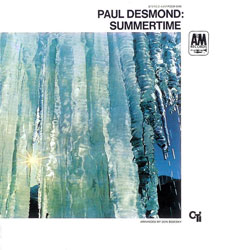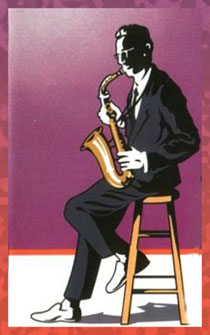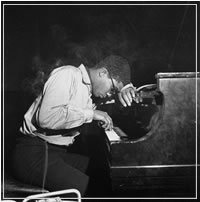

|
Soundclip:
|
| See Steve's Hand-Written Solo
Transcription |
Paul
Desmond's Alto Sax solo on:
"Emily"(Johnny Mandel) Recently, a student arrived and brought in a songbook asking if I could help him with the changes to Johnny Mandel's beautiful song, "Emily." My student was only familiar with a version by Jim Hall and George Shearing, which I didn't have here. However, I knew that he would love the Paul Desmond version, which appears on his recording, "SUMMERTIME"(A&M). "Emily" was recorded in Rudy Van Gelder's studio on October 16th, 1968. This will make the third transcription we have shared here from this recording. Previously, we featured the Desmond solo over "Where is Love?" and, the Herbie Hancock solo on "Samba with some Barbeque."  As I have previously stated, the supporting
performances by bassist Ron Carter, and Herbie Hancock are nothing short of spectacular, but spectacular for their sense of unobtrusive good taste, and, for simply listening to the music being made around them. Here Desmond's solo is but one chorus, with a rubato [Tag] used for the song's ending. As I have previously stated, the supporting
performances by bassist Ron Carter, and Herbie Hancock are nothing short of spectacular, but spectacular for their sense of unobtrusive good taste, and, for simply listening to the music being made around them. Here Desmond's solo is but one chorus, with a rubato [Tag] used for the song's ending."Emily", if my memory is not faulty, appeared in the film "THE AMERICANIZATION OF EMILY" which starred James Garner and Julie Andrews. This "theme song" appears in the classic A-A' song form, where A' is extended beyond the 16-bars one might expect, adding an extra 8-bars to the section. It is also most significant to note that it is a ballad played in 3/4, and the treatment it gets from the rhythm section gives it a special floating, almost timeless, quality. The drumming of Idris Muhammad, formerly known as Leo Morris, contributes greatly to this, as he almost never plays more than quarter-notes on a ride cymbal. The "sheet music key" for this tune is 'C.' But, Desmond plays it in Eb, which is, of course, the key of 'C' for that instrument. As it always is, the sheet music chord changes, which I had a chance to view, were not the best, but, in my experience, these were a little better than usual. However, I gave my student all the gorgeous changes from the Don Sebesky arrangement, which features a sensitively orchestrated brass section that greatly contributes to the sense of romance. People often criticize many of today's players for not being "melodic" enough in their improvisations. Paul Desmond has never suffered from such a problem, for he is consistently melodic. Perhaps this is because he plays so completely diatonically, consonantly through a tune such a this. Other than a couple of instances of chromatic neighboring tones, there is not a single instance of linear chromaticism to be found in the solo. And, more than this,  I believe that there is only one altered note in the entire
solo, and this appears as the B-natural(b9) in bar 4 of A' over the Bb7(13) chord. I think that, for
those of you who might be struggling to find the path to being more melodic, a careful examination of THIS solo might be very instructive for you. Now let's take a look at the specifics of this wonderful solo. I believe that there is only one altered note in the entire
solo, and this appears as the B-natural(b9) in bar 4 of A' over the Bb7(13) chord. I think that, for
those of you who might be struggling to find the path to being more melodic, a careful examination of THIS solo might be very instructive for you. Now let's take a look at the specifics of this wonderful solo.For those of you who have been regular visitors to KHAN'S KORNER, you would know that I don't use key signatures because, in my opinion, most popular music moves through so many tonal centers, even if ever-so-briefly, that it's not worth dealing with all the accidentals in that way. For example, in this tune, yes, it is fundamentally in the key of Eb, but bars 9-13 are in the key of 'C.' So, in essence through the first 8-bars, if one is playing very diatonically through the changes, you would expect to only see Ebs, Bbs, and perhaps an occasional Ab, though the 4th is often avoided, other than being a passing tone. And, this is exactly what you see. This style of improvising is the perfect way to play through the changes without observing each one individually! Desmond's approach to the first 8-bars of A' is exactly the same. Another contributing factor to the lyrcism of Paul Desmond is his relaxed sense of melodic development. This element is present throughout the solo. You can hear this in [A] during bars: 1-3; 5-8; 8-9. I must comment on the beauty of the little two-note motif he uses in bar 8 and then moves it up 1/2-step to mark the key change to 'C' major. To continue with the motifs, bars: 14-15. In [A'], bars: 1-5; 7-9; 9-16. In this way, her creates the sense that one line is flowing seamlessly into the next. And, this is the impression one wants to create. Note the usage of simple arpeggios: [A] bars: 1-2; 9-10; 11; [A'] bars: 1 and 17. Neighboring tones are used to surround the note he wants to target, [A] bars: 3-4; 14-16; [A'] bars: 1-8.  One of the characteristic problems in recording ballads, especially
during the age of the LP was that they simply take so much time to just state the melodies that
having extended solos becomes most difficult. So here, on this performance, there is only time for a once chorus solo and not even a restatement of any portion of the melody. Desmond plays right from the end of his solo into a rubato [Tag] section which I chose to notate for you all. Again, the very nature of this song, and its chord changes makes playing beautifully melodic lines seem effortless. The changes in this last section are lovely, and then some.
One of the characteristic problems in recording ballads, especially
during the age of the LP was that they simply take so much time to just state the melodies that
having extended solos becomes most difficult. So here, on this performance, there is only time for a once chorus solo and not even a restatement of any portion of the melody. Desmond plays right from the end of his solo into a rubato [Tag] section which I chose to notate for you all. Again, the very nature of this song, and its chord changes makes playing beautifully melodic lines seem effortless. The changes in this last section are lovely, and then some.Pay special attention to the glorious accompaniment of Herbie Hancock. In the area of accompaniment, there is really NO ONE like him. One could study his accompaniment alone, during the entire performance, and gain just as much. What Herbie plays, in a most understated and relaxed way, is truly a work of art. The beauty in this rendering of "Emily" is in its utter simplicity, its respect for the melody and the harmony which suppports it. For those of you who are learning about playing ballads with love and care, a study of this recording would be a good place to start. As always, we are wishing everyone the best of everything! [Photo of Herbie Hancock by Francis Wolff, Englewood Cliffs, New Jersey, December 24th, 1964.] |